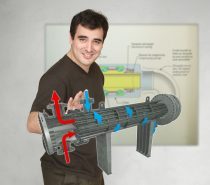
“Total Immersion Augmented Reality” by Eawentling
This is part of a regular series of articles exploring some of the terms used in e-learning (view other articles in the series). We’ll do our best to break down the jargon and explain what things are from a basic perspective.
Augmented Reality (AR) refers to technology which overlays additional information onto a person’s experience of the world. Typically, this means adding extra information to video and images (‘Visual AR’), but could also include the use of sound, smell / taste and touch as a way to provide the information (though the latter two are still in their infancy).
There are two main types of Augmented Reality: Target-based and Location-based. Each is useful for different purposes, however it is possible to combine the two.
Target-based AR uses unique images (known as targets or markers) to identify where and when to overlay the extra information. The location and orientation of the markers is tracked by the software and the display is updated accordingly. The video below is an example of target-based AR and shows how a smartphone or tablet can be used to display an animated 3D model of a bridge. The tracking can be seen in the video when the target image is moved around or rotated.
The other type of AR is location-based AR. This is different in that the information you see depends on where you are physically located in the world. A simple example of this is the ‘Plane Finder AR‘ app which allows a person to point their iPhone or iPad at a plane flying past and see information about it. This works by checking the location of the person, the direction they are pointing the camera of the device and matching that information with their list of current flights. Other examples of this type of AR include getting information about buildings and finding public transport information.
(As an aside, posters showing artwork started appeared around Sheffield in the past 12 months – these are AR enabled and will show extra information if you point a smartphone at them while running the correct app).
How is AR being used in education?
AR was used as part of a project at SHU to help nursing students to build empathy with simulation mannequins. This overlaid video of actors on the mannequins and encouraged the students to treat them as if they were real people. The project was the first use of AR in this setting and gained some media attention as a result (e.g. IET, The Guardian, ITV’s Calendar News). There is also a project currently in progress at SHU to make use of AR in Art and Design.
The SCARLET (Special Collections using Augmented Reality to Enhance Learning and Teaching) project started using AR to allow people to get additional information about items in academic and museum library special collections (such as rare books), but has since expanded into a number of other areas.
The cARe (Creating Augmented Reality in Education) project used AR to help nursing students develop clinical skills (target-based AR) and get an understanding of the socio-economic issues in the area around the hospital they would be training in to get a greater understanding of some of the medical conditions and histories that they might face (location-based AR). Part of this project included a 1-day event with presentations on the use of AR in education and videos of the sessions are online.
The following video is a great example of how AR can be used to help people learn to create simple electronic circuits and get more information about the components used. In this case, the AR experience helps learners to check that they have correctly designed and implemented the necessary circuit and provides various overlays to assist the learner.
The video on this page shows how (target-based) AR can be used to bring artwork to life and is a great example of how AR can be used to bring static resources to life. It seems likely that we will soon see textbooks that come with an AR features that help to illustrate the concepts being described.
What Next?
There is no denying that Augmented Reality is a fairly complex technology, however with careful consideration and the right skills it is possible to create immersive AR experiences that can really add to a learning experience. Rather than go into the technical details of setting up AR here, it is probably best to download some AR apps for your mobile device and try them out. The main apps are Blippar (example targets to scan), Junaio, and Aurasma (example targets to scan). While these apps have a marketing focus, they should help you get an idea of whether AR is worth looking at further.


